
Will M. Kennedy, Terra Petraea. The Archaeological Landscape of the Petraean Hinterland from the Hellenistic to the Byzantine Period (2021)
Pages: 632
ISBN 978-3-8325-5171-1
Logos Verlag Berlin | Site catalogue
To better understand the ancient Nabataean capital of Petra, it is important to consider its rural surroundings as well. The city's unfavorable geostrategic location makes this already clear: Situated in a deep valley and flanked by high mountain ranges, Petra's urban development was only possible through a well-structured organization of its surrounding landscape.
This study presents a first comprehensive archaeological and culture-historical characterization of the Petraean hinterland and researches overall strategies of the spatial organization of the city's rural environs.
Based on an extensive set of archaeological survey data from the Petra region, this study explores a variety of archaeological site types and features diachronically. While the main chronological focus is clearly set on the Nabataean and Roman periods, it also considers the preceding Iron Age and Hellenistic periods, as well as the subsequent Byzantine period.
The aim is to examine rural settlement patterns and subsistence strategies, aspects of rural water management, the extensive infrastructural network, the funerary and religious landscape, the military disposition, as well as the industrial potential of rural Petra.
Following a unique landscape archaeological approach, this study provides a differentiated analysis of the various archaeological sites and features for a broad, regional understanding of the Petraean hinterland and offers new insights into the socio-political and administrative, military, economic and infrastructural development of Terra Petraea through time.

Jean-Claude Mège-Bastet, Janick Roussel-Ode, Stephan G. Schmid (Hrsg.), Le Rocher des Aures et l’âge du Bronze autour de la Lance (2017)
Pages: 139
ISBN 978-3-8325-4489-8
Le Rocher des Aures, situé sur le terrain de la commune de la Roche-Saint-Secret-Béconne, en Drôme Provençale, consiste en un plateau calcaire triangulaire remarquablement détaché de la formation de la montagne de la Lance. Depuis plus d’un siècle, il fait l’objet de différentes activités de recherches archéologiques, mais c’est à l’instituteur de l’école de ladite commune, Alexandre Chevalier, que revient la découverte officielle, peu avant la première guerre mondiale, d’une occupation antique sur ce plateau. Cette découverte, et surtout l’identification du site avec l’antique Aeria, lieu central des Cavares décrit par Strabon, géographe grec d’époque augustéenne (fin 1er s. av. / début 1er s. ap. n.è.), s’inscrit dans le contexte d’un certain positivisme historique et archéologique.
L’étude des sites archéologiques se fait de nos jours dans une approche plus neutre, qui cherche entre autres à les positionner dans leur contexte régional. C’est ainsi qu’un nouveau programme de recherche, intitulé le « Projet archéologique du Rocher des Aures » a récemment vu le jour, et c’est également dans une telle optique qu’a été conçue l’exposition « Le Rocher des Aures et l’âge du Bronze autour de la Lance » présentée au Musée d’Archéologie et d’Histoire de Nyons et des Baronnies (2016-2017). Les diverses études et contributions réunies à cette occasion portent ainsi sur l’histoire de la recherche, qui a débuté en réalité plus tôt que ce qu’on l’on croyait, mais aussi sur le climat et les voies de communication antiques ainsi que sur les sites castraux du Moyen Âge.
Si le Rocher des Aures est présenté dans le contexte régional de l’âge du Bronze, et plus spécifiquement de la fin de cette période (ca. 1200-700 av. n.è.), c’est que les activités archéologiques récentes ont permis de déterminer que c’est principalement de cette époque que date l’occupation la plus importante du site, qui connaîtra un renouveau durant la fin de l’Antiquité et le Moyen Âge. Ainsi se dessine une image riche et diversifiée d’une civilisation déjà assez développée au début du 1er millénaire avant notre ère, précédant la célèbre culture des oppida de l’âge du Fer.

Zbigniew T. Fiema, Jaakko Frösén, Maija Holappa, Petra – The Mountain of Aaron. The Finnish Archaeological Project in Jordan. Vol. II. The Nabataean Sanctuary and the Byzantine Monastery (2016)
Pages: 602
ISBN 978-951-653-410-0
Jabal Hārūn (the Mountain of the Prophet Aaron), located near the ancient city of Petra in southern Jordan, is according to Jewish, Christian and Muslim traditions, the burial place of Aaron, Moses’ brother. Since 1997, the Finnish Jabal Hārūn Project (FJHP), directed by Prof. Jaakko Frösén and funded by the Academy of Finland and the University of Helsinki, has carried out archaeological excavations at a Byzantine monastery located on the high plateau of the mountain.
Volume II, which is the third and final publication of the FJHP publication series, is a major exposition of all excavated structures and the material remains associated with the entire occupation of the site (1st century A.D. – 11th/12th century A.D.), with the exception of the church and the chapel (FJHP volume I, 2008). Including 30 contributors and 23 chapters, this volume presents a wide range of subjects related to the history and archeology of the site and its structures. The publication concludes with a major presentation of the cultural history of the site. In addition, the volume is accompanied with a DVD that displays a virtual model and tour of the excavated church and the chapel.
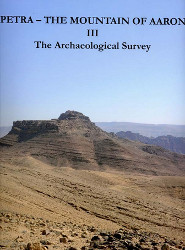
Paula Kouki, Mika Lavento, Petra – The Mountain of Aaron. The Finnish Archaeological Project in Jordan. Vol. III. The Archaeological Survey (2013)
Pages: 413
ISBN 978-951-653-410-0
Jabal Hārūn (the Mountain of the Prophet Aaron), located near the ancient city of Petra in southern Jordan, is according to Jewish, Christian and Muslim traditions, the burial place of Aaron, Moses’ brother. Since 1997, the Finnish Jabal Hārūn Project (FJHP), directed by Prof. Jaakko Frösén and funded by the Academy of Finland and the University of Helsinki, has carried out archaeological excavations at a Byzantine monastery located on the high plateau of the mountain.
The Finnish Jabal Hārūn Project (FJHP) consists of two interrelated parts: the excavation of the Byzantine monastery and pilgrimage center on the top plateau of Jabal Hārūn and the archaeological survey in the surroundings of the mountain. This volume concentrates on the FJHP archaeological survey. The volume is divided into two parts. The first part discusses the research history, survey methodology and the analyses of the collected data. The second part of this volume consists of the catalogue of sites documented by the FJHP survey. A map of the FJHP intensive survey area can be found in a pocket inside the back cover of this volume.

Michel Mouton, Stephan G. Schmid (Hrsg.), Men on the Rocks. The Formation of Nabataean Petra (2013)
Pages: 362
ISBN 978-3-8325-3313-7
Petra in modern southern Jordan is universally known as one of the most frequented touristic sites in the Near East, inscribed on the UNESCO world heritage list. Modern visitors are attracted by the romantic aspect of the rock-cut tomb façades, heavily contrasting in their baroque stile with the desert like surrounding of the rocky and arid landscape.
These monuments were the result of the long time presence of the Arab tribe of the Nabataeans who made Petra their capital when they became, at least partially, sedentarised during the Hellenistic period, i. e. between the late 4th to late 1st centuries BC.
How exactly this process of sedentarisation happened, how the site of Petra changed from a temporary dwelling place of a small Bedouin tribe to one of the blinking capitals of the ancient Near East that attracted – as it is the case today – visitors from all over the world, was the subject of a three years research program, jointly sponsored by the French Agence Nationale de la Recherche (ANR) and the German Research Foundation (DFG). At the end of the program, an international conference, held in Berlin in December 2011, brought together several dozen of scholars from all over the world in order to pinpoint the state of research on the Formation of the Nabataean capital.
The contributions of the present volume focus on questions related to the natural environment of the site, on the geology and geography as well as on architecture, small finds and social dynamics, probably the clue for a better understanding of the functioning of the Nabataean kingdom and its capital Petra.
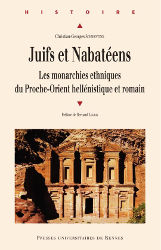
Christian-Georges Schwentzel, Juifs et Nabatéens (2013)
Pages: 306
ISBN 978-2-7535-2229-9
Presses universitaires de Rennes
Comment les monarques juifs et nabatéens parvinrent-ils à incarner leur ethnicité? Quelle était l’identité officiellement assumée par ces souverains? Par quels moyens l’imagerie officielle affichait-elle l’appartenance à un ethnos particulier, tout en revendiquant, le plus souvent, pour le monarque un statut équivalent aux autres rois contemporains? Cette ethnicité proclamée, qui semble toujours plus ou moins s’inscrire dans un contexte de bilinguisme culturel, n’était-elle pas fondamentalement ambiguë? Peut-on rapprocher les stratégies mises en œuvre par les souverains juifs et nabatéens de celles menées en Égypte par les Ptolémées, et enrichir ainsi la recherche sur les sociétés doubles ou janiformes des époques hellénistique et romaine?
Les tentatives de l’auteur pour répondre à ces questions constituent les principales lignes directrices de cet ouvrage, tiré d’un mémoire inédit de HDR, soutenu à l’université Paris I Panthéon-Sorbonne en novembre 2011. À la croisée des études anthropologiques et politiques sur le Proche-orient antique, ce livre se propose de mettre en évidence une forme spécifique de souverain: le monarque ethnique. Il met également en exergue des constructions politiques et identitaires originales, remettant en cause, au passage, la vision généralement défavorable qui caractérise les monarques hasmonéens ou encore Hérode le Grand dans l’historiographie traditionnelle.

Petra. Wunder in der Wüste. Auf den Spuren von J. L. Burckhardt alias Scheich Ibrahim (2012)
Pages: 80
ISBN 978-3-7965-2848-4
Tausende besuchen täglich die Ruinen von Petra in der jordanischen Wüste, die wenigsten wissen jedoch etwas über den Entdecker dieser Stadt: Am 22. August 1812, vor zweihundert Jahren, erreichte der Basler Johann Ludwig Burckhardt alias Scheich Ibrahim die Ruinenstätte. Er verband sie sogleich mit dem sagenumwobenen Petra, das im Westen in Vergessenheit geraten war. Der Schweizer Reisende legte damit den Grundstein für die Erforschung der Hauptstadt der Nabatäer, die heute zum UNESCO‑Welterbe gehört.
Aus Anlass dieses Jubiläums zeigt das Antikenmuseum Basel und Sammlung Ludwig die Ausstellung „Petra. Wunder in der Wüste. Auf den Spuren von J. L. Burckhardt alias Scheich Ibrahim“. Das Begleitbuch dazu fasst die neuesten Forschungsergebnisse zu den Nabatäern und Petra für ein breiteres Publikum auf attraktive Weise zusammen. Die reich bebilderten Beiträge haben international bekannte Fachleute verfasst. Sie beleuchten einerseits die verschiedenen Aspekte der nabatäischen Kultur im Allgemeinen und andererseits die nabatäische Hauptstadt Petra im Speziellen.
Woher kam dieses Nomadenvolk, wie wurde es sesshaft und wie gelangte es zu Reichtum? Welche Sprache verwendeten die Nabatäer und wie schrieben sie? Welche Götter verehrten sie und was wissen wir über den Kult und die Heiligtümer? Die Leserinnen und Leser erfahren auch, wie die Nabatäer es schafften, mitten in der Wüste eine ganze Stadt mit Tempeln, einem Theater und anderen öffentlichen Bauten zu errichten und mit Wasser zu versorgen. Man erfährt auch Neues über die Grabanlagen, die wohl bekanntesten Monumente Petras. Zudem werden die Ergebnisse einzelner Projekte vorgestellt, an denen auch Schweizer Forschende beteiligt sind, notabene Archäologen der Universität Basel, die zeitgleich zum Burckhardt‑Jubilaum auf 25 Jahre Feldarbeit in Petra zurückblicken können.
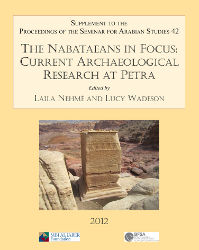
The Nabataeans in Focus: Current Archaeological Research at Petra. Supplement to the Proceedings of the Seminar for Arabian Studies, Volume 42 (2012)

Konstantinos D. Politis (ed.), International Conference „The World of the Herods and the Nabataeans“ held at the British Museum 17–19 April 2001. Volume II: The World of the Nabataeans (2007)
Pages: 392
ISBN 978-3-515-08816-9
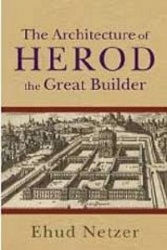
Ehud Netzer, The Architecture of Herod, the Great Builder. Texts and Studies in Ancient Judaism 117 (2006).
Pages: 443
ISBN 3-16-148570-X
Herod the Great was one of the famous builders of the classical world. Judaea, his kingdom, a crossroads between the Eastern Mediterranean countries, Mesopotamia, Arabia, and Egypt, symbolizes the transition between the Hellenistic and Early Roman periods as well as the climax of the Second Temple period, which witnessed the emergence of many religious and spiritual movements including Christianity. Beyond the influence of the matured Hellenistic architecture, the developing Roman architecture, and the local building activity of his predecessors, the Hasmonaeans, Herod’s buildings benefited from his analytical mind, creative imagination, and deep understanding of the process of building and planning. The consequences are outstanding structures such as Masada’s Northern Palace and Herodium’s cylindrical palatial fortress, and the peak of his achievements are Caesarea Maritima with its deepwater harbor and the rebuilding of Jerusalem’s Temple Mount.
Having an architectural as well as an archaeological background, Ehud Netzer is able to highlight Herod’s personal involvement and contributions in his building projects. This book presents, in many aspects, the first comprehensive synthesis of Herod’s enterprises from archaeological and, mainly, architectural viewpoints.
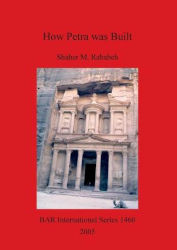
Shaher M. Rababeh, How Petra was Built. An analysis of the construction techniques of the Nabataean freestanding buildings and rock-cut monuments in Petra, Jordan. British Archaeological Reports (BAR) S1460 (2006)
Pages: 237
ISBN 184171898X
Abstract: Until now, no study has been made of the construction techniques of the Nabataean freestanding buildings and the rock-cut monuments of Petra, Jordan (built from the 1st cent. BC to the 2nd cent. AD). Their technical features were documented by fieldwork, and this evidence was then analysed to determine precisely when and why these features appeared or evolved. This leads to explaining how the Nabataeans developed their architecture, and what types of construction techniques they used to bring Petra’s architecture to its peak. The historical and geographical context for the architecture of Petra is presented, with a summary of previous scholarship on the site. The focus moves to the building materials used by the Nabataeans which are found to influence the construction techniques they developed. This is followed by a detailed discussion of quarrying and the rock-cut techniques. The procedures for dressing ashlar blocks and the facades of the rock-cut monuments are analysed to determine the tools used by the builders, as well as the lifting devices necessary for construction of the freestanding buildings. The technical aspects of the construction of walls, columns, floors, the anti-seismic and stabilising techniques developed by the Nabataeans are considered. Finally, the construction of roofs is examined in detail. The results of the study reveal the sources of the building techniques used at Petra and why they were further developed there.
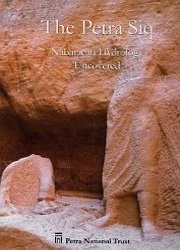
Isabelle Ruben (ed.), The Petra Siq: Nabataean Hydrology Uncovered (2003)
Pages: 140
ISBN 9957855506
The Petra Siq is an in-depth presentation of results from excavations between 1996 and 2000. The excavations re-expose the ‚Siq‘ as the Nabataean’s sacred entrance to Petra ans its significance to religion in Nabataean society; whilst highlighting the importance of the ‚Siq‘ as part of the larger water management system of the area.
